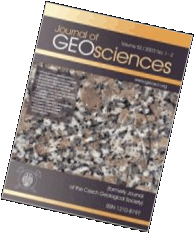 Export to Mendeley
Export to MendeleyOriginal Paper
Ore-forming processes and mineral parageneses of the Jáchymov ore district
Journal of the Czech Geological Society, volume 48 (2003), issue 3-4, 157 - 192
The contribution provides characteristics of the so-called five-element Ag-Ni-Co-Bi±U formation, points to differences in sources of the U formation and the Ag-Ni-Co-Bi-As formation, and presents a model of element fractionation in abyssal hydrothermal sources according to physical-chemical properties of the compounds. The role of arsine (AsH3) in the mobility of the triad Ni-Co-Fe is discussed. A new scheme of mineralization stages is proposed in relation to three sources, separated in space and time: 1. greisenization of granite: Sn-W sulpharsenide stage. 2. U formation: carbonate-uraninite stage. 3. Ag-Ni-Co-Bi-As formation: arsenide, arsenic-sulphide, and sulphide stages. A new geochemical and thermodynamic interpretation of hydrothermal processes of individual mineralization stages is presented, including a detailed discussion of thermodynamic conditions of UVI mobility and uraninite precipitation. Redox potentials of hydrothermal environment after the carbonate-uraninite stage including crystallization of silver and bismuth dendrites, precipitation of Ni-Co-Fe polyarsenides and electrochemical dissolution of Ag and Bi dendrites are also discussed. Mechanisms of the precipitation of base metal sulphides and sulpharsenides are considered in relation to redox conditions and sulphur fugacity in the environment during individual stages of mineralization. Phase relations are used for the deduction of the conditions of formation of selected ore minerals. Diagrammatic interpretation of chemical analyses and substitution trends of selected minerals or mineral groups, and a paragenetic relation of primary and secondary minerals are used in the interpretation. A discussion of the dependence of weathering processes on mining activity is included. Data on fluid inclusions and stable isotopes are used for the interpretation of ore-forming processes.
Webdesign inspired by aTeo. Hosted at the server of the Institute of Petrology and Structural Geology, Charles University, Prague.
ISSN: 1803-1943 (online), 1802-6222 (print)
email: jgeosci(at)jgeosci.org


IF (WoS, 2024): 1.3
5 YEAR IF (WoS, 2024): 1.4
Policy: Open Access
ISSN: 1802-6222
E-ISSN: 1803-1943